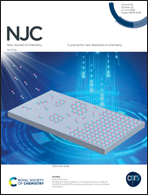An anthracene-based microporous metal–organic framework for adsorbing CO2 and detecting TNP sensitivity†
Abstract
A new anthracene-based metal–organic framework (MOF, named as CUST-607), [Cd3(H2O)(H3L)2(dia)2]·4DMA·10H2O (dia = 9,10-bis(1H-imidazol-1-yl)anthracene, H3L = 4,4′,4′′-[1,3,5-benzenetriyltris(carbonylimino)]tris(benzoate)), was synthesized by a solvothermal method. Through single X-ray diffraction analysis, CUST-607 displays a three-dimensional multihole network with the triclinic space group of P![[1 with combining macron]](https://www.rsc.org/images/entities/char_0031_0304.gif) and (3,3,4,5)-connected nodes. Gas adsorption and desorption experiments show that CUST-607 has a microporous structure with a large surface area of 702.15 m2 g−1. CUST-607 also exhibits selective and strong adsorption of CO2 with a 40 kJ mol−1Qst value. Luminescence sensing experiments show that CUST-607 has a high selectivity for detecting nitroaromatic explosives, particularly for 2,4,6-trinitrophenol. The quenching constant Ksv is 1.43 × 105 M−1, higher than that of most reported MOFs. In addition, the CUST-607 fluorescence sensor exhibits high recyclability in detecting nitrobenzene and 2,4,6-trinitrophenol and can be used as potential sensors in practical applications.
and (3,3,4,5)-connected nodes. Gas adsorption and desorption experiments show that CUST-607 has a microporous structure with a large surface area of 702.15 m2 g−1. CUST-607 also exhibits selective and strong adsorption of CO2 with a 40 kJ mol−1Qst value. Luminescence sensing experiments show that CUST-607 has a high selectivity for detecting nitroaromatic explosives, particularly for 2,4,6-trinitrophenol. The quenching constant Ksv is 1.43 × 105 M−1, higher than that of most reported MOFs. In addition, the CUST-607 fluorescence sensor exhibits high recyclability in detecting nitrobenzene and 2,4,6-trinitrophenol and can be used as potential sensors in practical applications.



 Please wait while we load your content...
Please wait while we load your content...